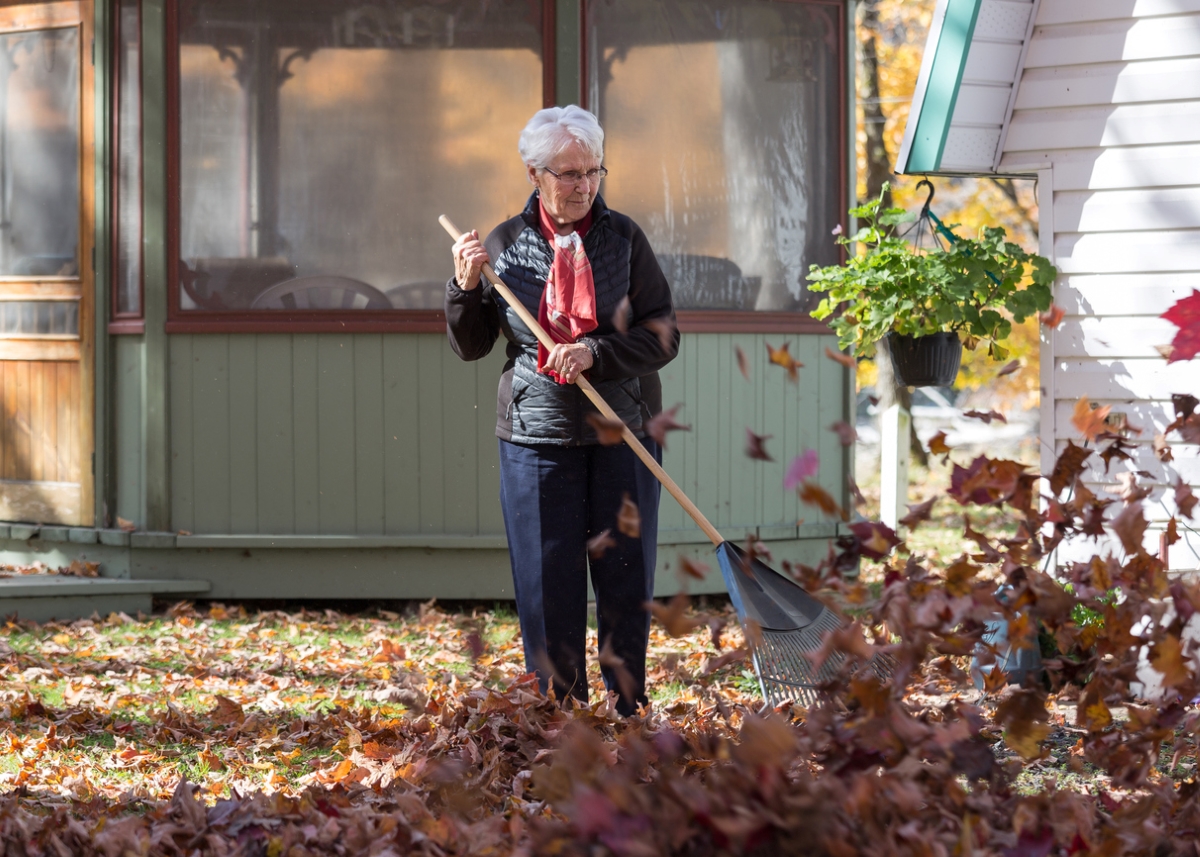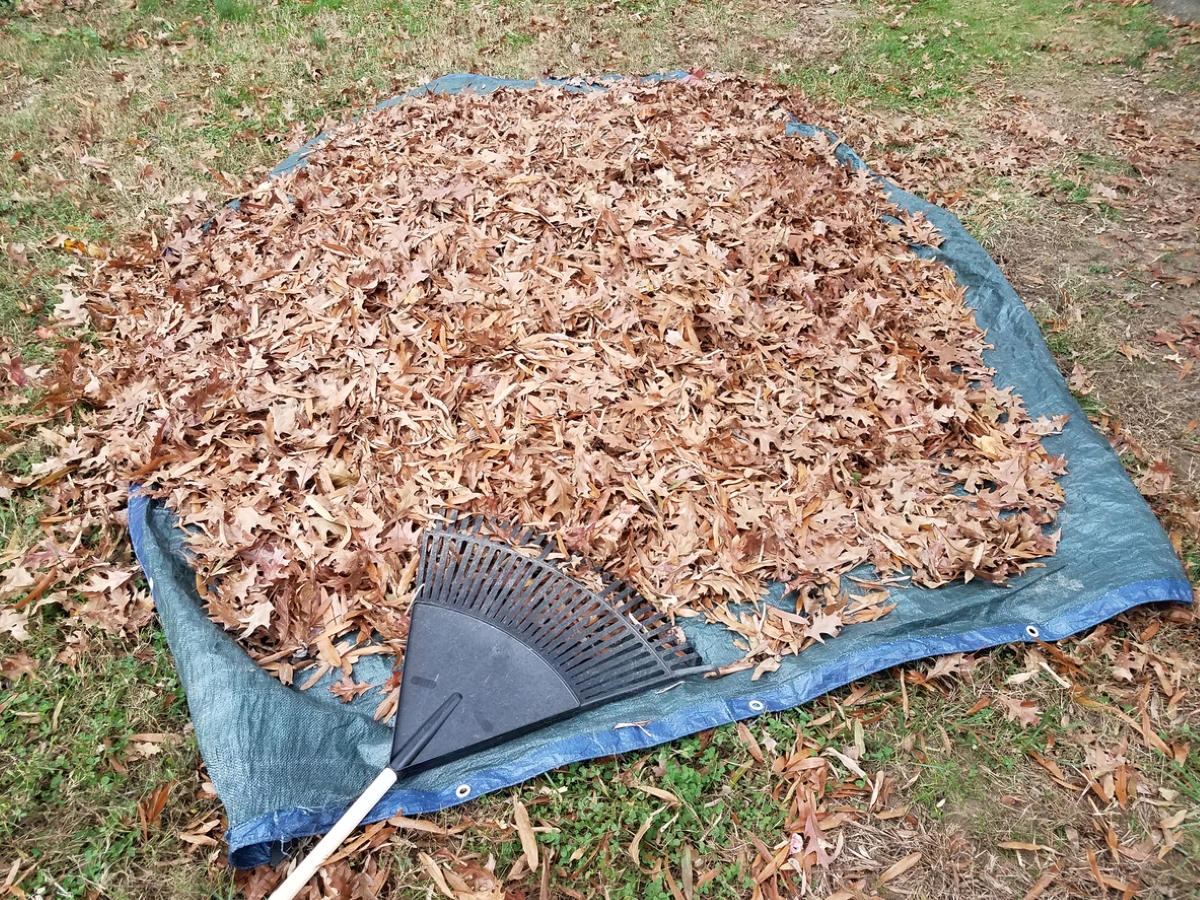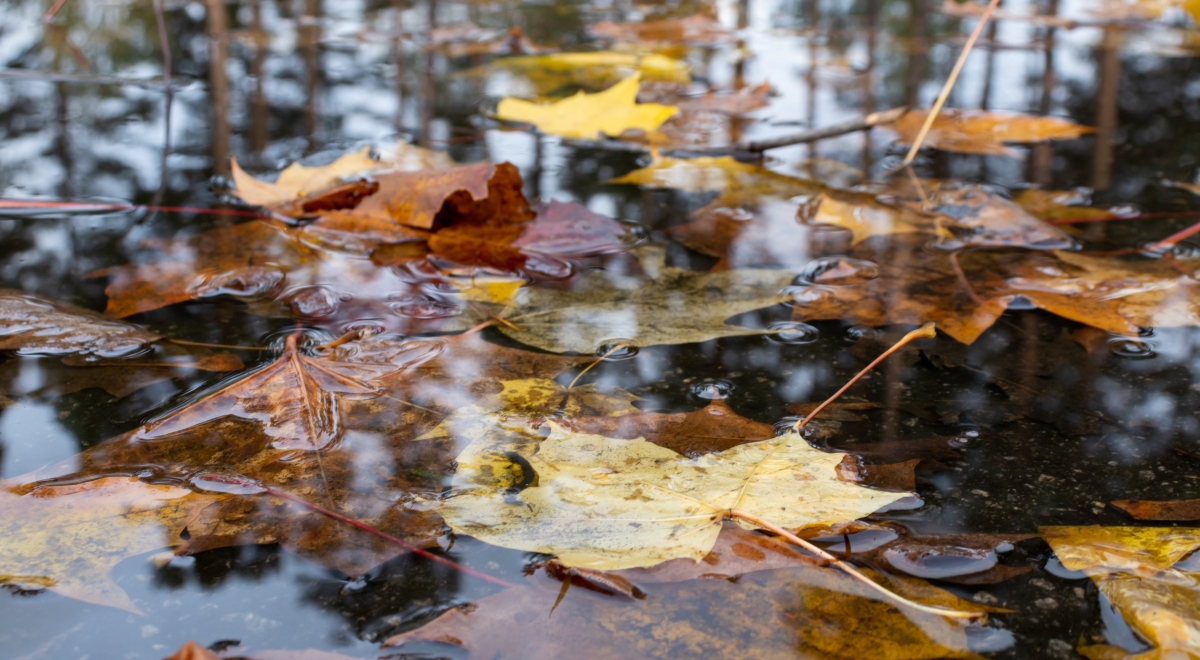

We may earn revenue from the products available on this page and participate in affiliate programs. Learn More ›
Few things in nature are as striking as brilliant red and gold foliage in autumn. But even the most beautiful deciduous leaves eventually fall, and when too many of them accumulate in your yard, those untidy piles can smother the lawn, impede the growth of cool-season grasses, and attract pests.
While cleaning up these fallen leaves might seem like a constant chore, it doesn’t have to be. Leaves can serve a more important purpose than just cluttering up the lawn. They can be valuable assets for both the environment and the yard.
In fact, many experts advocate leaving the leaves where they fall. David Mizejewski, a naturalist with the National Wildlife Federation, hopes that homeowners keep the fallen leaves on their property. “[Leaves] are an important habitat for all sorts of wildlife from songbirds to butterflies and moths; even some of our native bees rely on that natural layer of leaves that fall as habitat,” Mizejewski says. “If you throw them all away in the landfill, not only does that completely eliminate the habitat for these wildlife, it’s also throwing away a valuable resource.”
Whether you want to discover safe and effective ways to get rid of leaves in your yard or learn how leaves can benefit property and wildlife, we have some lessons that will make handling fallen leaves in the yard a breeze.
1. Wait for leaves to finish falling.

You can’t rush Mother Nature. It’s pointless to start raking when the trees are still full of leaves. Save valuable time by waiting until the trees are practically bare before tackling the job. It can take a few days or even a few weeks before all the leaves have fallen, but by waiting, you’ll only have to rake once.
2. Always take comfort into consideration.

Raking is dusty business. You’ll be more comfortable if you don a hat, a long-sleeved shirt, and long pants before getting started. It’s also wise to wear a good pair of work gloves, like OZERO Flex Grip leather work gloves, to keep blisters from forming on your hands and offer a bit of warmth on chilly fall days. Also, remember to stand up straight while raking and frequently switch the leading hand on the rake to prevent arm and shoulder fatigue.
RELATED: 9 Tricks for Fast and Easy Fall Yard Cleanup
3. Use the right rake.

Leaf rakes come in various lengths and tine widths, and the best rake for one person might not be the best for another. Rakes with narrow tine spreads gather fewer leaves and add unnecessary time to the chore, so homeowners can choose varieties with a wider tine spread of about 30 inches.
Also, look for rakes labeled “no-clog,” such as the True Temper Clog Free Rake. No-clog rakes have angled tines that won’t pierce the leaves and create blockages.
RELATED: The Best Leaf Rakes to Keep Your Yard Looking Beautiful, Tested
4. Rake with the wind.

Take advantage of breezy autumn weather by raking in the same direction that a gentle breeze is blowing. The gusts will help move the dry leaves along. If you make the mistake of raking against the wind, every stroke of the rake will lift some leaves, which can then be blown backward.
The exception to this rule is when the wind is brisk. When that’s the case, don’t rake at all. By the time you finish raking, leaves from the neighbor’s yard will likely have replaced those you raked up from yours. What’s the point?
5. Rake in rows.

Raking all the leaves into the center of the lawn will mean constantly running back and forth, wasting a lot of time and energy. Instead, separate the lawn into quadrants, then rake all the leaves in each quadrant into rows, working from one end to the other. Raking the leaves in a grid pattern will save time and result in a cleaner lawn.
RELATED: The Invincible Yard: 25 Ideas for Lazy Landscaping
6. Save time and trouble with tarps.

Bagging large piles of leaves is a time-consuming task. Reduce the workload by raking the leaves onto a large tarp. When you’re done raking, tie the ends of the tarp together and transport the entire “bag” to a community collection center. Alternatively, roll the tarp into a cylinder and use it as a funnel to fill individual lawn bags.
A high-quality, lightweight tarp can be reused many times and will last for years. Some tarps, such as the Rocky Mountain Goods Drawstring Tarp, are specially designed for raking up leaves. With its drawstring corners, it folds up into a handy bag for toting leaves away.
7. Bag smaller piles.

Unless you plan to rake the leaves into a large pile for the kids to jump in, it’s a good idea to bag them straight away. Otherwise, the brisk autumn breeze can undo all your hard work, and require another raking session in the same zones.
With environmentally friendly biodegradable bags such as these 30-gallon lawn and leaf bags from Tapix, the leaves and the bag can be tossed into a community’s leaf collection station. Some communities require dumping leaves out of plastic bags to keep the plastic, which doesn’t biodegrade readily, out of the leaf piles.
RELATED: 330 Plants That’ll Bring Color to Your Yard This Fall
8. Invest in a leaf vacuum.

To streamline the leaf-removal process, consider investing in a leaf vacuum with a built-in shredder. The vacuum sucks up the leaves, and the shredder minces them into small bits to collect more leaves in fewer bags—or mulch the leaves into smaller pieces that can stay in place and break down more easily to enrich soil and lawn beneath.
Yard vacuums also make it easier to pick up leaves under shrubs, between bushes, on top of stone mulch, and in other places where raking can be tricky. A cordless leaf vacuum, such as the Greenworks 40V Vacuum, makes this task a snap. It’s battery-operated, so you aren’t limited by the length of an extension cord or relying on gas to power the tool.
9. Mow and mulch at the same time.

Get rid of small amounts of fallen leaves while simultaneously adding organic mulch to the lawn. Simply mow over the leaves with a lawn mower, ideally one with a mulching setting. The blades will chop the dry leaves into small flakes, which will decompose quickly and add nutrients to the lawn.
Those looking for organic matter to add to a compost pile can attach a grass-clipping bag to the mower and collect the shredded dry leaves. Whole leaves can also go into a compost pile, but shredded leaves biodegrade more quickly.
RELATED: The Best Leaf Mulchers of 2025 to Make Yard Care a Cinch, Tested
10. Use a leaf blower, with these caveats.

Leaf blowers can significantly reduce cleanup time after raking, but only if they’re used correctly. Start by sectioning out the yard and establishing a grid pattern, then work the leaf blower back and forth in rows. Remember that practice makes perfect with leaf blowers. At first, many people have a tendency to stand too close to the leaves, which can blow them wildly in all directions.
Those who are serious about moving a lot of leaves should consider a backpack-type blower, such as the Husqvarna Backpack Blower, that allows the user to carry the motor on the back rather than lugging it around by hand, leaving both hands free.
It’s important to note, however, that a lot of lawn and yard maintenance equipment—particularly gasoline-powered tools—can add to pollution. “Those lawn mowers, weedwackers, and blowers that are powered by gasoline are putting out awful amounts of carbon dioxide and other air pollutants,” Mizejewski says. “Our advice at the National Wildlife Federation is that if you do have to use them, you want to at least go with electric models,” he adds. He notes that electric models produce significantly less air and noise pollution.
“Those lawn mowers, weedwackers, and blowers that are powered by gasoline are putting out awful amounts of carbon dioxide and other air pollutants. Our advice at the National Wildlife Federation is that if you do have to use them, you want to at least go with electric models.”
— David Mizejewski, a naturalist with the National Wildlife Federation
11. Rake before rain.

After a rainstorm, fallen leaves become soggy and dense, clumping together and clogging rakes, vacuums, and leaf blowers. If the forecast predicts wet weather and raking is on the to-do list, get moving and clean up the lawn ASAP.
If time allows, it’s also a good idea to clean leaves out of house gutters before it rains. When they’re dry, they’re so much easier to rinse away using an extendable rod that attaches to a pressure washer, such as the AgiiMan Gutter Cleaning Rods.
RELATED: 15 Easy DIYs for Instant Autumn Curb Appeal
12. Sweep with gentle motions.

Unlike the raking done to prepare a garden bed for planting, leaf raking requires only gentle motions. The flexible tines on a leaf rake should not dig into the lawn nor remove thatch. Leaf-raking is all about surface raking. Putting downward pressure on the rake head will just make the job more difficult.
Lift the rake head up and out, and let it fall softly on the surface of the leaves. Then, just pull it toward you. The bent shape of the tines is sufficient for grabbing and pulling the leaves. Using an efficient leaf-raking method will help get the job done quickly and effortlessly.
13. Use leaf scoops.

Once the leaves are all in a pile, picking them up and filling bags or boxes is often more work—and more stress on the back—than it has to be. A much simpler way to lift and load the dry leaves is with leaf scoops that look like a giant claw for each hand. When worn on both hands, the scoops make it easy to lift large amounts of leaves at a time.
Leaf scoops such as these leaf scoops from Garden HOME, will help when gathering piles of leaves and bagging or moving them in quick order.
RELATED: The Best Leaf Rakes to Keep Your Yard Looking Beautiful, Tested
14. Try shoveling leaves.

Most would never think of using a shovel to gather dry leaves from the lawn, but that may be because they’re not familiar with rake shovels. A rake shovel is different from other types of rakes. It looks a little like a snow shovel, and it’s designed to push along the surface of a lawn. Unlike a standard snow shovel blade, it has tines that glide across the lawn, picking up leaves and small twigs.
A rake shovel, such as the MLTOOLS Gardening Rake Shovel, offers another way of cleaning up leaves. Rake shovels can help reduce arm and back fatigue are best suited for homeowners with small yards.
15. Stomp before you take a break from raking.

Life happens, and sometimes you’ll have to take a break from raking even if you’re not done to answer a phone call, pick up the kids from soccer practice, or feed the dog.
If you’ve already raked those lightweight leaves into a pile, they might blow across the lawn by the time you get back. However, there’s a little leaf-raking tip that can help: Stomp on the pile. Stomping on the leaves compacts them and helps keep most from blowing away before raking recommences.
RELATED: Why Mulching Leaves Is Better Than Raking Them
16. …Or don’t rake at all.

“My best advice would be to just not rake,” Mizejewski said. “Let the leaves lie where they fall. The most natural and the most beneficial thing to do is to just let your yard be totally natural.” This supports insects and small wildlife, especially in areas without lawn turf.
Leaving some leaves unraked in the yard has been shown to be quite beneficial for both property owners and the environment. According to the U.S. Department of Agriculture, leaves create a natural mulch that helps retain soil moisture, which reduces some of the need to water the lawn and promotes healthy soil. This natural mulch also can suppress weed growth, saving time and effort on weeding.
“Let your lawn turn into a natural garden bed that you can fill with beautiful wildflowers and native trees and shrubs. Use that natural leaf layer as a mulch,” Mizejewski says.
17. Break up large leaves and thick layers.

Another reason to skip raking is that yard debris, including leaves, accounts for more than 13 percent of solid waste in the U.S. This waste releases the greenhouse gas methane if there’s not enough oxygen to decompose.
However, even the USDA suggests mulching the leaves that remain on turf. Leaving large and thick leaves on grass over the winter can smother the turf, preventing light from getting through to roots and creating matted layers. Excessive leaf matter also can lead to mold-related diseases. Use one of the methods above (mowing with a mulcher, or mincing in a vacuum or blower) to break up some of the leaves and let them remain in a thin layer (about an inch). Or cart them off to serve as mulch in a garden bed to repurpose leaves instead of disposing of them.
